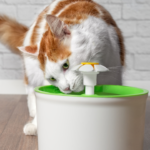
Why adopt an older cat?
June 1, 2015
Potpourri: Hazard to Cats
December 3, 2015What is feline leukemia virus (FeLV)?

What is feline leukemia virus (FeLV)?
Feline leukemia virus (FeLV), a retrovirus, so named because of the way it behaves within infected cells. All retroviruses, including feline immunodeficiency virus (FIV) and human immunodeficiency virus (HIV), produce an enzyme, reverse transcriptase, which permits them to insert copies of their own genetic material into that of the cells they have infected.
Although related, FeLV and FIV differ in many ways, including their shape: FeLV is more circular while FIV is elongated. The two viruses are also quite different genetically, and their protein consituents are dissimlar in size and composition. Although many of the diseases caused by FeLV and FIV are similar, the specific ways in which they are caused differs.
How common is the infection?
FeLV-infected cats are fund worldwide, but the prevalence of infection varies greatly depending on their age, health, environment, and lifestyle. In the United States, approximately 2 to 3% of all cats are infected with FeLV. Rates rise significantly—13% or more—in cats that are ill, very young, or otherwise at high risk of infection.
How is FeLV spread?
Cats persistently infected with FeLV serve as sources of infection. Virus is shed in very high quantities in saliva and nasal secretions, but also in urine, feces, and milk from infected cats. Cat-to-cat transfer of virus may occur from a bite wound, during mutual grooming, and (though rarely) through the shared use of litter boxes and feeding dishes. Transmission can also take place from an infected mother cat to her kittens, either before they are born or while they are nursing. FeLV doesn’t survive long outside a cat’s body—probably less than a few hours under normal household conditions.
What cats are at greatest risk of infection?
 Cats at greatest risk of infection are those that may be exposed to infected cats, either via prolonged close contact or through bite wounds. Such cats include:
Cats at greatest risk of infection are those that may be exposed to infected cats, either via prolonged close contact or through bite wounds. Such cats include:
- Cats living with infected cats or with cats of unknown infection status
- Cats allowed outdoors unsupervised, where they may be bitten by an infected cat
- Kittens born to infected mothers
Kittens are much more susceptible to infection than are adult cats, and therefore are at the greatest risk of infection if exposed. But accompanying their progression to maturity is an increasing resistance to FeLV infection. For example, the degree of virus exposure sufficient to infect 100% of young kittens will infect only 30% or fewer adults. Nonetheless, even healthy adult cats can become infected if sufficiently exposed.
What does FeLV do to a cat?
Feline leukemia virus adversely affects the cat’s body in many ways. It is the most common cause of cancer in cats, it may cause various blood disorders, and it may lead to a state of immune deficiency that hinders the cat’s ability to protect itself against other infections. The same bacteria, viruses, protozoa, and fungi that may be found in the everyday environment—where they usually do not affect healthy animals—can cause severe illness in those with weakened immune systems. These secondary infections are responsible for many of the diseases associated with FeLV.
What are the signs of disease caused by FeLV?
During the early stages of infection, it is common for cats to exhibit no signs of disease at all. However, over time—weeks, months, or even years—the cat’s health may progressively deteriorate or be characterized by recurrent illness interspersed with periods of relative health. Signs can include:
- Loss of appetite
- Slow but progressive weight loss, followed by severe wasting late in the disease process
- Poor coat condition
- Enlarged lymph nodes
- Persistent fever
- Pale gums and other mucus membranes
- Inflammation of the gums (gingivitis) and mouth (stomatitis)
- Infections of the skin, urinary bladder, and upper respiratory tract
- Persistent diarrhea
- Seizures, behavior changes, and other neurological disorders
Click here to find out how to keep your cat from becoming infected >
Source: vet.cornell.edu






